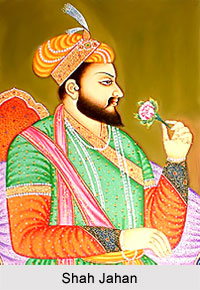 Siege of Qandahar was a major blow to the Mughals. This citadel commanded a strategic position, controlling the mountainous pass towards the Afghan country, and was the crossroad through which thousands of caravans passed. Akbar had captured this fortress in 1623. Later, the Persians won it back, but then the treacherous Persian governor, Ali Mardan Khan, surrendered it to the Mughals in 1638 and it had been with the Mughal Empire since then. While Shah Jahan was at the Red Fort in Delhi, it was announced that the Shah of Persia was moving towards Qandahar with intent of capture. Shah Jahan had already received reports from his spies as well as the governor of Qandahar Khwas Khan that the Shah was intending to march on this citadel. On 27 August 1648, the army of Shah Abbas II was already in Mashhad in Khorasan, not far from Afghanistan. As soon as the sovereign heard this news, he prepared an army of 60,000 cavalry and artillery with 150 Amirs and put this army under Aurangzeb`s command. He also appointed Sadullah Khan `Minister of Pen and Sword` and left Shahjahanabad himself for Kabul, along with this force and his newly appointed minister. His intention was to reach Qandahar before the first snowfall.
Siege of Qandahar was a major blow to the Mughals. This citadel commanded a strategic position, controlling the mountainous pass towards the Afghan country, and was the crossroad through which thousands of caravans passed. Akbar had captured this fortress in 1623. Later, the Persians won it back, but then the treacherous Persian governor, Ali Mardan Khan, surrendered it to the Mughals in 1638 and it had been with the Mughal Empire since then. While Shah Jahan was at the Red Fort in Delhi, it was announced that the Shah of Persia was moving towards Qandahar with intent of capture. Shah Jahan had already received reports from his spies as well as the governor of Qandahar Khwas Khan that the Shah was intending to march on this citadel. On 27 August 1648, the army of Shah Abbas II was already in Mashhad in Khorasan, not far from Afghanistan. As soon as the sovereign heard this news, he prepared an army of 60,000 cavalry and artillery with 150 Amirs and put this army under Aurangzeb`s command. He also appointed Sadullah Khan `Minister of Pen and Sword` and left Shahjahanabad himself for Kabul, along with this force and his newly appointed minister. His intention was to reach Qandahar before the first snowfall.
Unfortunately, his advisers assumed that the Shah of Persia would never attack during the winter months, and the Emperor listened to their counsel. So he stopped at Multan to muster his strength. There would be no point in taking his troops up into the mountains in the freezing winter if it was not necessary. But against all expectations, the Persian army, with a strength of 50,000 cavalry, mostly Qizilbash warriors, a tribe with a fierce reputation, and supported by high-performance artillery which the Shah had imported specially for this campaign, reached the walls of Qandahar in the middle of December. The Emperor, Aurangzeb, and Sadullah Khan were in Multan studying what tactics they should adopt when news of this unforeseen development reached them. Without waiting for any auspicious date from his astrologers, Aurangzeb set off for Qandahar immediately with the main army, the senior council following with their contingents as soon as they could organize themselves. However, the going was rough in the freezing cold, with snow and blizzards blocking the roads and passes. It was a race against time, and in Qandahar, the Persian sovereign knew it. He had to capture the fort before the Mughal reinforcements arrived. On 25 February, the fortress fell after a two-month siege. The garrison, overcome by hunger and the extreme cold, surrendered. They lost only 400 soldiers, but the Qizilbash lost 2,000. If the Mughals had been able to hold on for two more days, the outcome would have been very different, but once again in their campaigns against the Persians, the Mughals were too late.
 When Aurangzeb`s army approached Shah Abbas, having achieved his objective, retreated and left a small contingent to defend the fort. Aurangzeb thought he could overtake the Persians at Berar by 28th February. Finally the two armies would have confronted one another, at a time when the Qizilbashis were exhausted after battle. However, the Emperor heard optimistic reports that the Persian sovereign had left the fort practically unguarded and he felt it would be easier to quickly recapture the citadel, even though the main enemy army was still intact and in the vicinity. But other reports confirmed that the fortress was well guarded. The Emperor kept vacillating, issuing orders and then reversing them.
When Aurangzeb`s army approached Shah Abbas, having achieved his objective, retreated and left a small contingent to defend the fort. Aurangzeb thought he could overtake the Persians at Berar by 28th February. Finally the two armies would have confronted one another, at a time when the Qizilbashis were exhausted after battle. However, the Emperor heard optimistic reports that the Persian sovereign had left the fort practically unguarded and he felt it would be easier to quickly recapture the citadel, even though the main enemy army was still intact and in the vicinity. But other reports confirmed that the fortress was well guarded. The Emperor kept vacillating, issuing orders and then reversing them.
Aurangzeb ignored all these contradictory orders and rode after the main Persian force, but they crossed the high range of Hazarjat, north of Qandahar, and seemed to disappear in the mountains. Aurangzeb tried in vain to follow this army, then he had to give up and rejoin the Emperor and Sadullah Khan, who had begun to lay siege to the fort. The minister had already had trenches dug around the citadel, which was the usual strategy for a siege. But Shah Abbas`s army was still unbeaten, and he sent back a powerful contingent of 30,000 men under Murtaza Quli Khan to break up the blockade. Confronted with such a strong force, Aurangzeb had to restrict himself to skirmishing, but this continuous fighting only depleted his men while the enemy gained strength. The vain efforts of these two armies to cripple each other continued for four months. The Emperor eventually realized that if this went on, he would waste his entire army, so once more he gave up and ordered retreat.
 Due to his failed strategies and procrastinating, Shah Jahan had lost two to three thousand men and five thousand horses and mules, and the financial loss was considerable. Worst of all, there would now be no revenue from Qandahar. On 25 October, the Emperor returned to Lahore, where he met Dara Shikoh and Sadullah Khan again. Aurangzeb and General Rustam Shah Bahadur made some final forays against the Qizilbashis across the Hindu Kush, and they even managed to capture some cannons, but the fact was that they had been defeated. They joined the Emperor later.
Due to his failed strategies and procrastinating, Shah Jahan had lost two to three thousand men and five thousand horses and mules, and the financial loss was considerable. Worst of all, there would now be no revenue from Qandahar. On 25 October, the Emperor returned to Lahore, where he met Dara Shikoh and Sadullah Khan again. Aurangzeb and General Rustam Shah Bahadur made some final forays against the Qizilbashis across the Hindu Kush, and they even managed to capture some cannons, but the fact was that they had been defeated. They joined the Emperor later.
Aurangzeb was sent back to his governorship of Multan immediately. However, his father had condescended to add the rich town of Thatta on the Indus to his jurisdiction, and in 1650, when he visited Delhi again to pay his respects to his father, Shah Jahan relieved him of his charge of Multan and made him governor of Malwa, in Rajasthan.
In the meantime, the Emperor had not resigned himself to the loss of Qandahar. He went back to Lahore again and began making plans to re-conquer this citadel with Rustam Shah Bahadur, Sadullah Khan, his Amirs, and the Rajput princes. If it was her father`s wish then it was her wish and, always foremost in a good cause, Jahanara made it her mission to win back Qandahar. She invested her influence and fortune in this undertaking. From her own purse she raised an army of 400,000 men and had Aurangzeb nominated Supreme General. This time Shah than took every measure to attain victory. He took 50,000 cavalry, artillery with platforms to transport the cannons, and 600 Amirs and Mansabdars. The treasury advanced three months` pay.
Again Shah Jahan lavished favours, ceremonial robes, and money on Aurangzeb. Then, on the most auspicious day selected by the astrologers, Shah Jahan left Lahore for Kabul to take command of the operations. He arrived there on 13 April 1652, after a difficult two-month march, and marched on towards Qandahar. Sadullah Khan also left Kabul with his army to join the attack. Aurangzeb left Multan on 26 July. The siege had started on 12 May, the date chosen by astrologers, so was well under way by the time he arrived. The assault had begun to the sound of trumpets and artillery fire by the Mughal army, but the Persians were prepared. They returned the fire with cannonballs, grapeshot and guns. They repulsed attack after attack of the Mughals, and dead bodies heaped up around the ramparts. The Qizilbashis made forays at night, massacring the soldiers in their trenches, on one occasion attacking Sadullah I Khan and Rustam Shah`s forces, taking prisoners and carrying away cannons. The artillery of the Persians was imported, state-of-the-art weaponry and superior to that of the Mughals. In the intense fighting, the Mughal cannons began to overheat while the Persians went on ravaging the Emperor`s lines.
Aurangzeb`s role in this campaign was not so prominent, and Shah Jahan called for Murad Bakhsh and Dara Shikoh during the course of the war. Jahanara`s presence was also indirectly there on the battlefield. After fighting an intense war in which he did all he could to capture the fortress, finally the Emperor had to give up and withdraw his forces. After the unfortunate campaigns in Qandahar, Aurangzeb was reappointed to the Deccan. Thus, at the head of his cavalry and his royal procession, the Prince returned to the capital he had built, Aurangabad, in the last months of the year 1652.






































